2024 NFL Draft WR Rankings, Grades, and Profiles
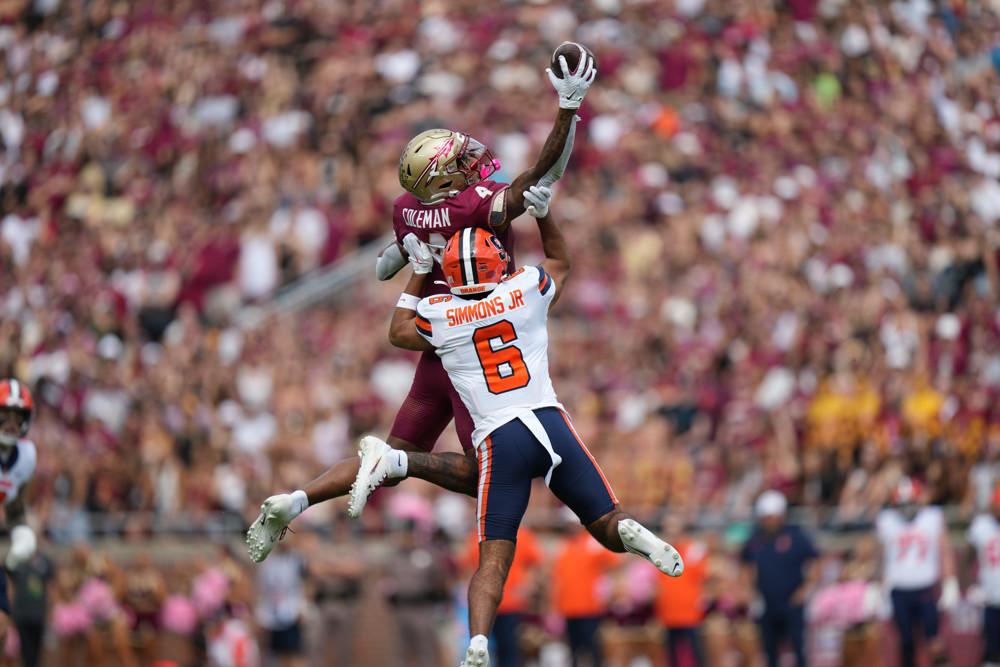
Let's talk about modeling for WR prospects. The conversation starts and stops with draft capital. Once we know where these guys are drafted, almost every single metric we add to a model adds very little value. There's still value to coming up with a model -- in fact, I have one in here -- but it's best to keep things simple and not overfit a trend that doesn't actually exist moving forward.
I use age adjusted production, team strength, and team share of production as the other inputs in my model. That way, I'm boosting players who declared early, went to the best programs, and then dominated once on the field. But it turns out, the production doesn't add a whole lot of value to the model as long as draft capital is in it because NFL teams obviously like production when drafting players!
Ironically, the metric that adds the most value beyond draft capital is team strength, which for me is a combination of strength of schedule and SRS on college football reference. Many of the busts in Round 1 come from below-average programs, possibly because the jump in competition was overwhelming or possibly because it's harder to scout against bad competition. This "fade small school" trend could become even more important with the new college transfer rules, too. If a prospect was unable to transfer from a smaller program to a big program after producing early, that's a bigger red flag now. Some examples of transfer upgrades in this class are Keon Coleman leaving Michigan State for Florida State, Ricky Pearsall going to Florida, Tez Walker to North Carolina, Brenden Rice and Tahj Washington to USC. I'm just not sure how many Corey Davis (Western Michigan) and Breshad Perriman (Central Florida) types we're going to see in Round 1 moving forward.
As always, declaring early is also another very good sign regardless of production. Players get feedback from scouts on if they are good enough to leave, so we should take notice whenever we see a junior in the draft class. A similar proxy is looking at age, with the obvious case being it's more impressive to ball out when the prospect isn't fully developed. If we combine these two principles (big programs and age), the 8 prospects in this class that check boxes are Marvin Harrison Jr, Malik Nabers, Rome Odunze, Brian Thomas Jr, AD Mitchell, Keon Coleman, Xavier Worthy, and Troy Franklin. Congrats to us. We found the best prospects in consensus rankings without pulling up their box scores or their combine results. All we did is value the opinions of college recruiters and NFL scouts, both who have a lot of stake in getting their evaluations right.
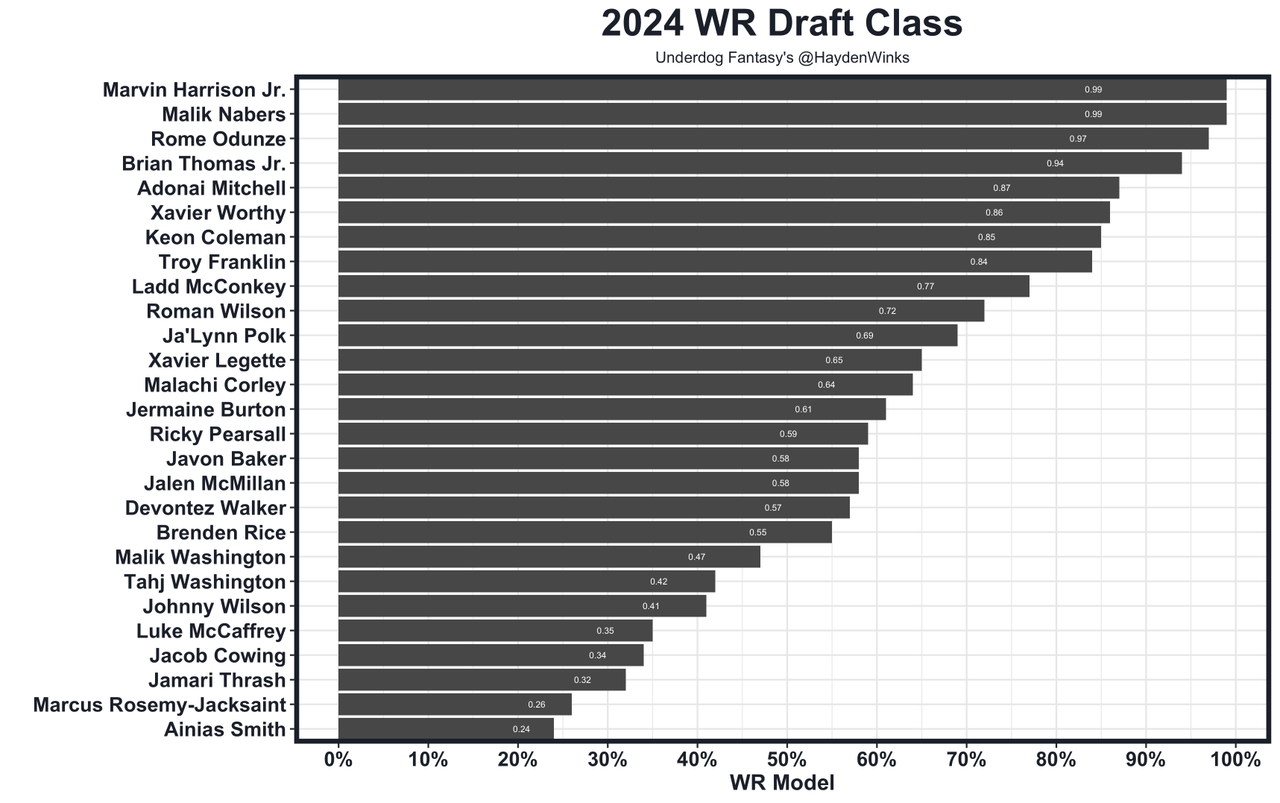
WR1 Marvin Harrison Jr. (Early Round 1)
WR Model: 99th percentile
Comps: A.J. Green, DeAndre Hopkins, Alshon Jeffery, Allen Robinson
Not many prospects of his age (21.8 years old) and size (6'4"/205) have the route running mastery that Harrison Jr. has. He's a classic physical X receiver who played on the outside on 80% of his snaps. He's tempo-altering in his movements, with the ability to drop his hips on breaking routes. The Ohio State product can run every route, can beat against press man coverage, and has the ball tracking ability to win in contested situations. His "and one" mentality is reminiscent of DeAndre Hopkins, but Harrison Jr. is two inches taller. His 89th percentile age-adjusted production would've been much better with a more experienced QB during his junior season, but even with up-and-down play around him, he still only trailed Malik Nabers in first downs per route (0.14) and yards per route (3.4). If there's something holding him back from the other rare WR prospects, it's his yards after catch production and total acceleration. He only forced 5 missed tackles in 2023 and doesn't routinely blow by defenders on go routes like the Julio Jones or Justin Jefferson types. He's still fast enough and creates separation on deeper routes because he threatens all blades of grass, can play with leverage, and absorbs contact in the air. In general, Harrison Jr. is close to the total package and a candidate for 80-100 receptions as a rookie.
WR2 Malik Nabers (Early Round 1)
WR Model: 99th percentile
Comps: Ja'Marr Chase, Odell Beckham, Jaylen Waddle
He's outrageously explosive in all phases: go balls, out of the break, and with yards after the catch. Nabers changes how defenses have to play, and even then, he can win from multiple alignments and on multiple routes. He was utilized inside (54% snaps) and out (46%), and short and deep (12.2 aDOT). He bounces off defenders after the catch but more importantly has the burst to run right by them. His ball tracking ability is very impressive for someone moving as fast as he does, which helped him put up an 89-1,568-14 receiving line (class-high 97th percentile age adjusted production) primarily against SEC competition. He also led the class in yards per route (3.6) and first downs per route (16%). Only 20 years old on draft night, Nabers has room to develop at the line of scrimmage because he's a bit smaller than other No. 1 WRs, but physicality isn't an issue for him in general. While in the route, he already uses tempo and body control to create separation, on top of being a straight-up better athlete. They used him on slot fades, go balls, posts, and corners most often, but anything underneath is well in his bag. This is the Ja'Marr Chase profile reincarnated.
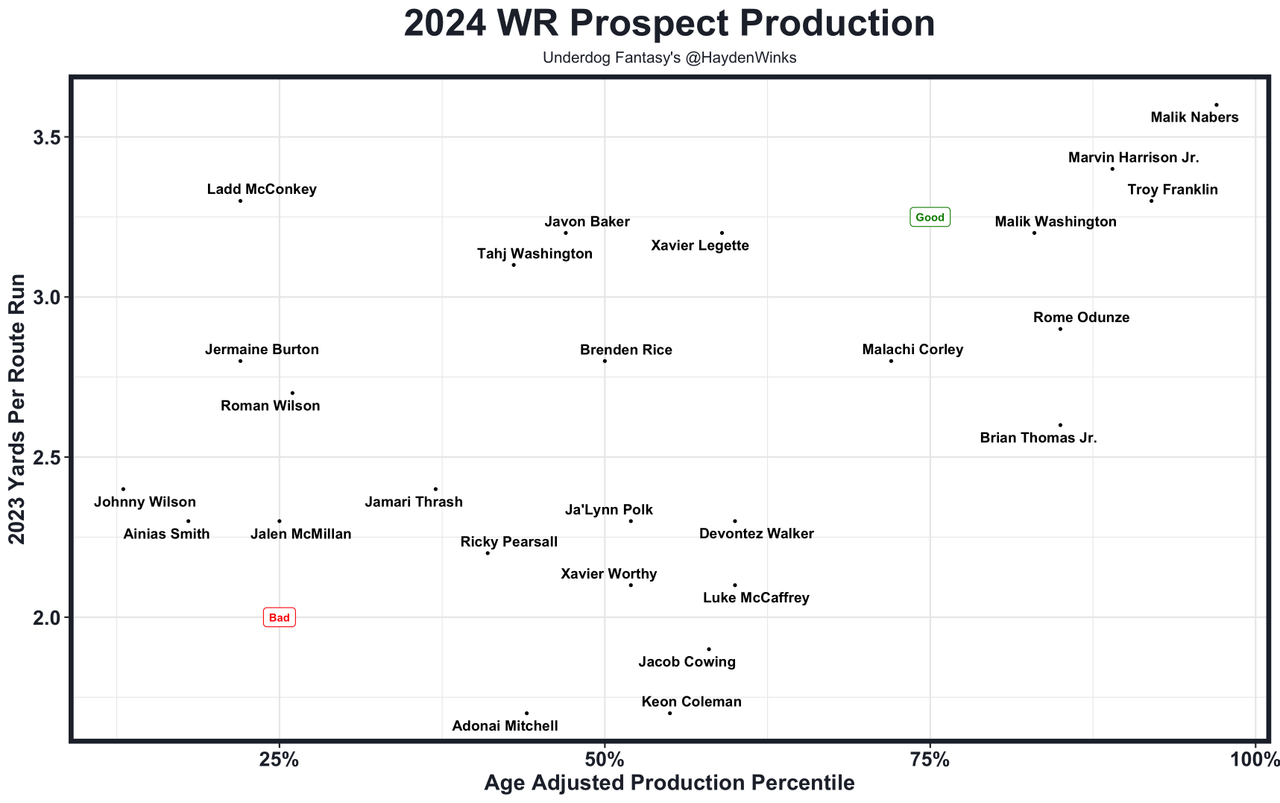
WR3 Rome Odunze (Early Round 1)
WR Model: 97th percentile
Comps: DeAndre Hopkins, Dez Bryant, Alshon Jeffery, Courtland Sutton
A high school track star out of Vegas, Odunze developed across four seasons at Washington in a vertical-based offense (15.5 aDOT). He finished his senior season with 85th percentile age-adjusted production (109 yards per game) while primarily operating at X receiver on the outside (82% snaps). His best traits are his physicality and ball tracking. He converted an absurd 75% of his contested situations per PFF, often winning in the air on slot fades and double moves from the perimeter at 6'3"/212. He's also a pain in the ass to tackle. Just don't mistake him as a plodding, contested catch artist. Odunze has 4.47 speed and a fantastic repertoire of routes. He plays with tempo and can bend his hips (93rd percentile short shuttle), making him a threat on every single route. The senior declare doesn't have blazing speed (47th percentile), but he will create separation and can beat press man coverage like a No. 1 target. Odunze is a fantastic interview, too.
WR4 Brian Thomas Jr. (Mid Round 1)
WR Model: 94th percentile
Comps: Mike Wallace, Martavis Bryant, Terry McLaurin, D.J. Moore
Stuck in LSU's WR rotation as a freshman and sophomore, Thomas broke out in a major way (85th percentile age-adjusted production) as a true junior next to Malik Nabers. Their spread offense was a perfect fit for Thomas' 4.34 speed. He caught 15-of-22 deep targets for 670 yards and 12 TDs. For those counting at home, that's 30.4 yards per target! Insane. Thomas stands tall (6'3"/209) compared to other speedsters. He play through contact downfield and in the red zone, plus can sink his hips on comeback routes. In fact, 42% of his targets were hitch routes that forced him into plenty of stop-start situations. His yards after catch ability signals that he can be a full route tree player with more development, especially since he's just 21 years old and has shaken press man defenders from the outside (87% snaps). Thomas wasn't asked to run many in- or out-breaking routes, so there is some projection with his profile, but his athletic traits (95th percentile speed score) are very hard to find. Only four of his receptions came behind the line of scrimmage, so his elite 19.9 half PPR points per game came on very real reps. He could be an NFL WR1 even though he wasn't targeted like one in Baton Rouge.
WR5 Ladd McConkey (Late Round 1)
WR Model: 76th percentile
Comps: Garrett Wilson, Chris Olave, Tyler Lockett, Zay Flowers
The stats are forgettable. McConkey only averaged 11.2 half PPR points per game (22nd percentile age-adjusted production) over his last two seasons at Georgia in their run-heavy offense, and he didn't declare early. But the rest of the profile is enticing. McConkey led the Power 5 in EPA per route (+0.30), led in individual points earned per route (+0.17), and was the WR2 in success rate on his targets (70%), so he balled out whenever needed. His 4.39 speed and 90th percentile agility are immediately noticeable on tape. Lining up on the outside on 79% of his snaps, McConkey was able to work downfield against off coverage (12.2 aDOT) at times, but his bread and butter is at the top of the route. His start-stop speed and explosion out of breaks is exceptional, as long as he's not completely eaten up by a physical corner. McConkey is a separator on real routes and shows elite short-area burst on Mickey Mouse touches, including off screens. In the motion era of the NFL, he could be an OC's favorite weapon because of his versatility. The key will be to keep him away from press man coverage where his lack of size (5'11/186) works against him, potentially meaning more slot snaps at the next level. In the right system and with better injury luck, McConkey can be a major box score filler.
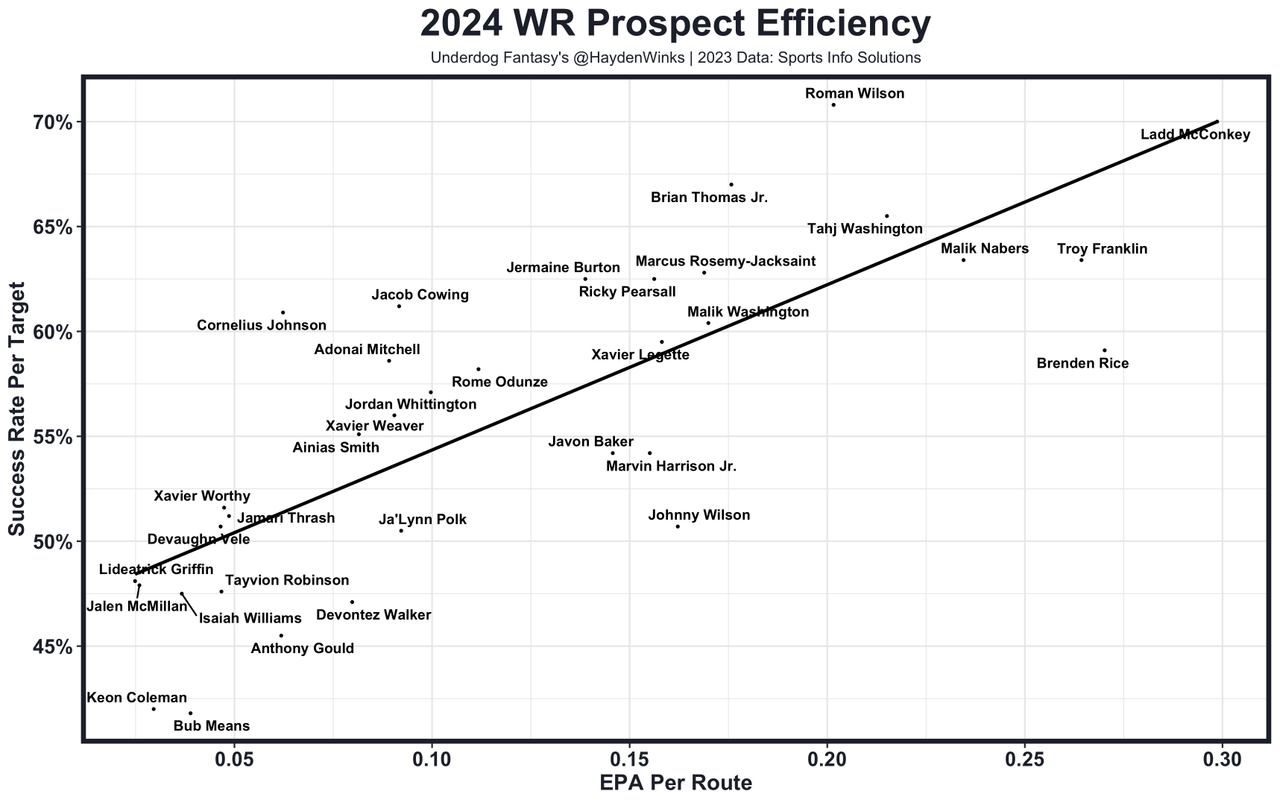
WR6 Adonai Mitchell (Early Round 2)
WR Model: 87th percentile
Comps: Sammy Watkins, Martavis Bryant, DeVante Parker, Denzel Mims
Mitchell is a gifted athlete with 92nd percentile size-adjusted speed (4.34 forty at 6'2"/205), but his production at Georgia and Texas was very inconsistent. He's best on downfield routes (16.0 aDOT) where he can glide past defenders, particularly on start-stop double moves from the perimeter (82% snaps outside). He has some red zone touchdowns on fade routes because he offers a large catch radius and 92nd percentile hops, and he can create separation on slant routes (at times!) because of his explosiveness. At the very least, Mitchell is a low-volume deep threat that can line up at X or Z, but there's work to be done to be a well-rounded receiver. Mitchell's route running lacked urgency, which also showed up in his blocking reps. There were double digit wasted reps per game for whatever reason. He had very little production on breaking routes where he sometimes would slip at the top of his route, not fight back to the ball enough while playing through contact, or body catch. His inconsistency with his hands could explain why he has some of the worst yards after the catch numbers (3.2 yards per catch) of any 4.34 speedster. Ever. All this ultimately hurt his total production. His 1.7 yards per route run and 9% first down rate are below average, and his age-adjusted production sits at just 44th percentile among drafted WRs since 2000. Mitchell has the tools to be a difference maker, but he's a boom-bust prospect that left me equally impressed and frustrated. Ultimately, 21-year-old early declares from major programs with his size and speed are worth betting on.
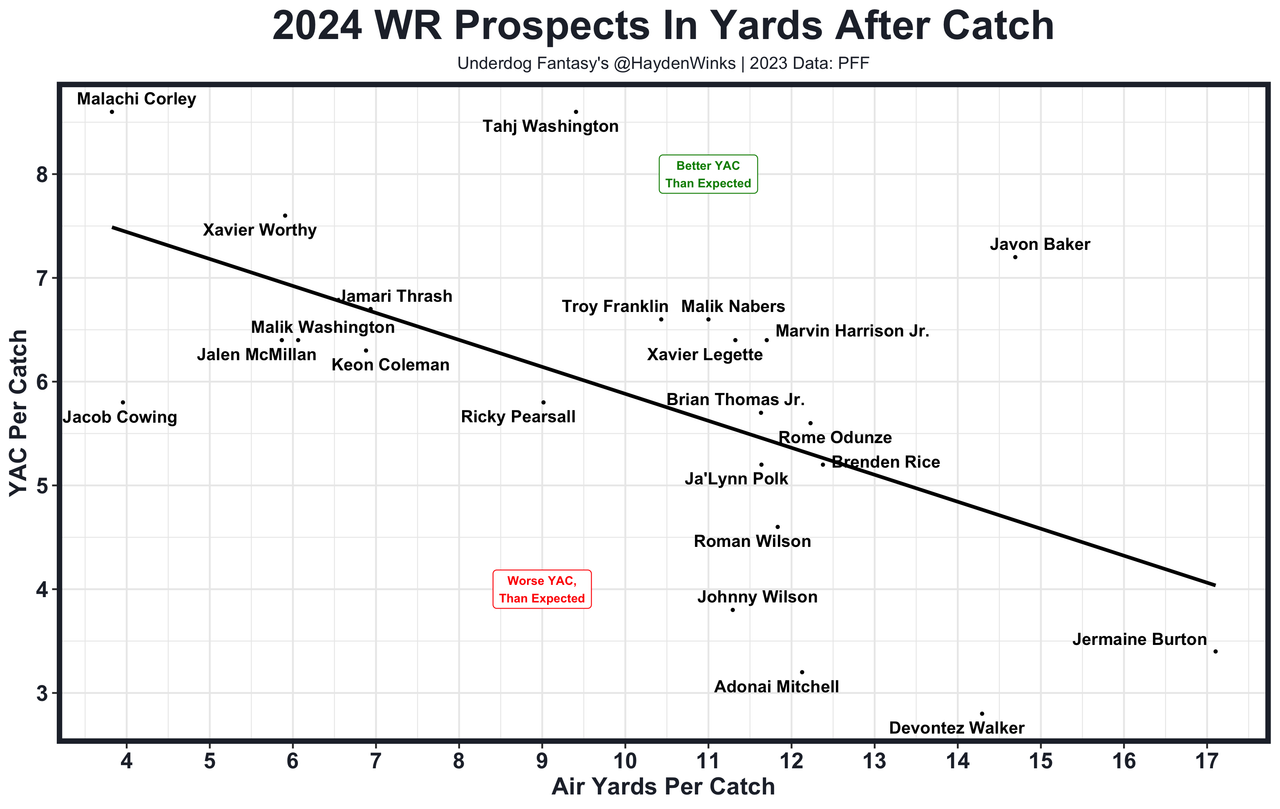
WR7 Xavier Worthy (Early Round 2)
WR Model: 84th percentile
Comps: Marquise Brown, Tyler Lockett, Brandin Cooks, T.Y. Hilton
A record-setting 40-yard dash (4.21 seconds) will live with Worthy's profile for eternity and likely pushes him into the Round 1 discussion, despite weighing 165 pounds. Very, very few players at that size have been high-volume WRs even if they run like the wind, but the NFL is changing. Worthy can be used on "cheat motions", in the slot (40% of his snaps), in the screen game (21% of his targets), or in bunched sets if his size does work against him at the line of scrimmage. That wasn't much of a problem in college because corners were respecting his deep speed at truly hilarious levels, but it's worth noting that 39% of his 75 receptions came behind the line of scrimmage because Texas threw so many screens to him.
Down the field, Worthy can cut off his deep routes on a dime. He obviously can run past defenders, too. His primary weak spot is at the catch point, and it was a very real problem. He caught just 5-of-21 contested opportunities, sometimes not being big enough in jump ball situations downfield and sometimes allowing CBs to reach through him on shallower routes. That likely can't be fixed given his petite frame, and it could prevent him from being a 120-target player. There were also some reps where he took the play off or his ball tracking lapsed. Ultimately, his 0.05 EPA per route and 51% target success removing screens are among the worst in the class. Quinn Ewers' inaccuracies and these negative traits explain his just fine junior production (12.3 half PPR per game) and 6-of-23 deep-target catch rate.
He will still be a threat off play action, similar to rookie-year Tank Dell, because he can tempo his routes. Worthy's early-age production (led Texas in receiving as a freshman, sophomore, and junior) separates him from the John Ross bucket, and his route nuance separates him from Tutu Atwell, Marvin Mims, and Anthony Schwartz tier. The NFL Draft throws out failed DeSean Jackson comparisons annually, but Worthy's odds of turning into D-Jax are higher than most. His most likely outcome is being in the Jameson Williams and Tank Dell conversation as a dangerous No. 2 or No. 3 receiver.
WR8 Ricky Pearsall (Round 2)
WR Model: 62nd percentile
Comps: Jerry Jeudy, Sterling Shepard, Less Physical Julian Edelman
It's hard to be any smoother and quick-footed in the underneath part of the field, and Pearsall's NFL Combine performance solidified his tape. Taller than most traditional slot WRs, the 23-year-old Florida alum posted a 4.41 forty, 97th percentile vertical, 96th percentile three cone, and 90th percentile short shuttle. In other words, Pearsall is a crazy athlete. There are clips of him winning on the perimeter and downfield, but his game is best underneath. He's particularly crafty on option routes and has the speed to pull away on crossing routes out of the slot. He caught 16-of-17 targets between 0 and 10 yards downfield, plus had an 80% success rate on his catchable targets out of the slot. There's a flash to his game that can occasionally work against him and he isn't going to break many arm tackles, but Pearsall is too athletic to not be used in the motion and screen game in these modern NFL offenses. He has the skillset to be a PPR scam with yards after the catch ability. The case against Pearsall is simple. His share of pass-game production is only in the 58th percentile despite being a 5th-year senior, his age-adjusted production is in the 41st percentile, and his 6'1"/189 frame provides some on-tape limitations.
WR9 Keon Coleman (Round 2)
WR Model: 85th percentile
Comps: Poor Man's Drake London, Gabe Davis, JuJu, Mo Sanu
It was a collegiate career filled with what ifs and poor QB play, but Coleman at least has the size (6'3"/213) and big catch ability to suggest there's an upside to chase despite a 55th percentile age-adjusted production profile. Coleman, only 21 years old on draft night, wins on jump fades (75th percentile jumps) in the red zone, double moves on the perimeter, and in contested catch situations over the middle. His best five reps in the air rival any prospect. He just didn't showcase the rest of the route tree beyond go routes, hitches, and screens. His short-area agility and physicality translate to after the catch situations, which explains the increased screen usage at Florida State. It's possible he can run more breaking routes with more development, but his 4.61 forty time and 23rd percentile weight-adjusted speed will always work against him. Luckily his play speed is faster than that (he had the fastest MPH on the gauntlet drill at the Combine) because he's confident with his hands and can play through contact with very impressive balance. In the NFL, Coleman is most likely to be a dirty work secondary WR that can stay on the field in all occasions, despite his worrisome 1.7 yards per route run and 7% first down per route rate averages. Those numbers would've been better with less touch competition (RB Trey Benson, WR Johnny Wilson, TE Jaheim Bell, and QB Jordan Travis rushing). Don't rule out a transition from outside to the slot.
WR10 Troy Franklin (Late Round 2)
WR Model: 83rd percentile
Comps: Jameson Williams, Darnell Mooney, Jalin Hyatt, Quentin Johnston
His slender frame (6'1"/176) is problematic, especially after testing as a 36th percentile adjusted SPARQ athlete. He plays faster than his 4.41 forty time, but Franklin rarely showed wiggle so his 30th percentile short shuttle wasn't a surprise. On tape, he's ideal for play action deep shots using go balls, posts, and deep crossers to utilize his difference-making straight line speed. Like others of this field-stretcher mold, Franklin had some untimely drops (10% per PFF), especially while working over the middle, but in general, he tracks the ball well over his shoulder and can use his length to his advantage. Expect him to struggle in the slant and in-breaking world because press defenders can play through him and he currently doesn't trust his hands. Ultimately, Franklin's 92nd percentile age-adjusted production (3.3 yards per route run and 20.2 half PPR per game) and early declare status make him an intriguing second round selection, even if there are some limitations on tape heading into the draft.
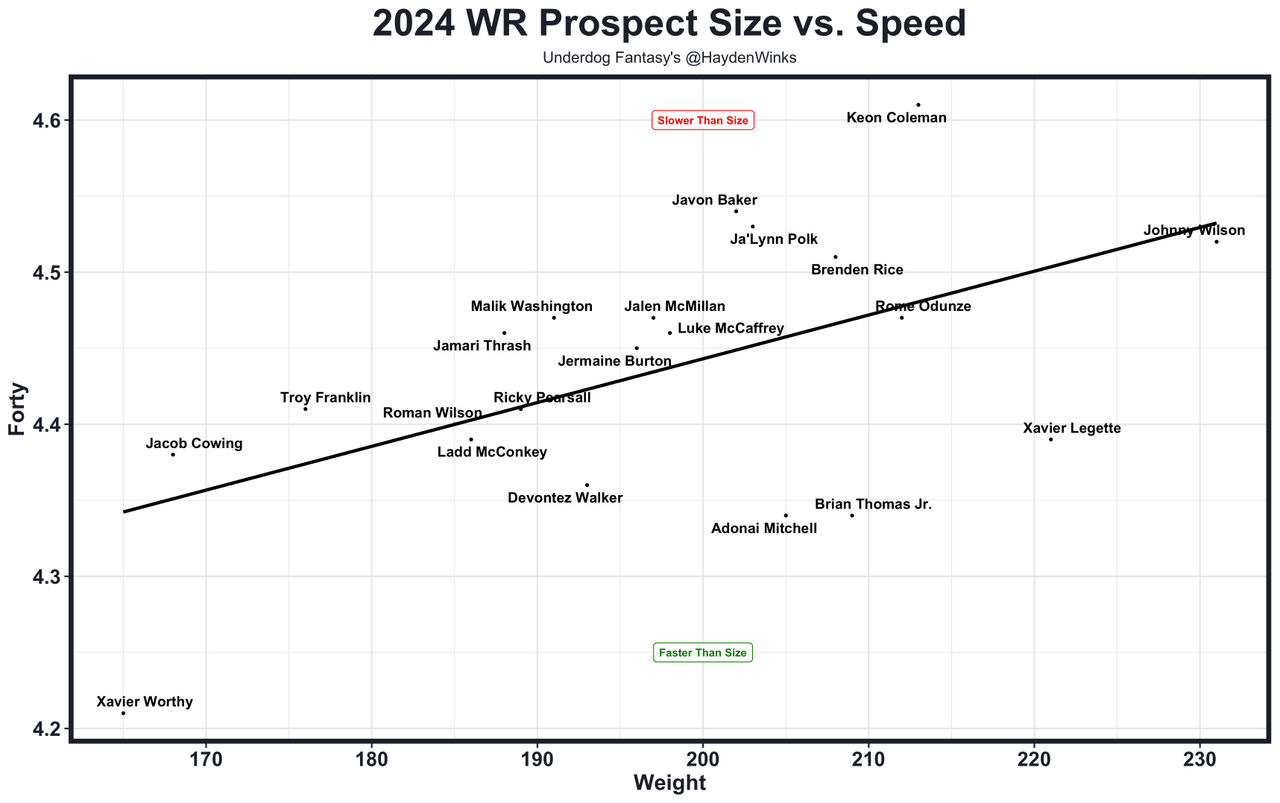
WR11 Ja'Lynn Polk (Late Round 2)
WR Model: 69th percentile
Comps: Marvin Jones, Josh Palmer, Rashee Rice
The sidekick to Rome Odunze at Washington, Polk showcased versatility while playing inside and outside (59% snaps). He has average size (6'1"/203) and 30th percentile size-adjusted speed (4.53 forty), so his gritty style does some heavy lifting for his profile. Polk is more physical than his size and can win on back shoulder routes downfield. He is a crafty route runner but doesn't have the acceleration to create a bunch of separation. He made some acrobatic grabs in the air, then dropped some passes in contested situations when knocked off his spot. In general, his traits are just solid, but it's easy to see Polk eating snaps because of his versatility, effort, and feel for zone coverage. He ran a lot of hitch, crossing, and go routes in college, leading to 52nd percentile age-adjusted production on 2.3 yards per route run.
WR12 Johnny Wilson (Late Round 2)
WR Model: 41st percentile
Comps: Marques Colston, Kenny Golladay, Dorial Green-Beckham
How many 6-foot-7, 231-pound humans can run 4.53 in the forty with an 82nd percentile short shuttle and 81st percentile broad jump? Almost all of them play in the NBA. Wilson isn't without warts both statistically and on tape, but there are sleeper qualities in his profile because he's so unique. He surprises defenders with his speed on intermediate and downfield routes, then becomes a handful to work through at the catch point. For his size, Wilson has a nice plant foot underneath, too, sometimes showing separation ability within 10 yards. He can pluck errant throws with his record-setting wingspan, but his hands aren't consistent. Wilson can play out of control, both at the catch point and while running his routes. There were some flailing contested catches on some passes that had no business being thrown. There were also some easy drops and potential yards after the catch opportunities lost because of his hands. These issues led to a 13th percentile age-adjusted production, an 11% drop rate, and just 3.8 YAC per reception. Wilson likely is a situational outside receiver to start his NFL career, but there's an easier path to success than I expected. Ultimately, Wilson is a great athlete at rare size. That's not an exaggeration.
WR13 Jermaine Burton (Late Round 2)
WR Model: 61st percentile
Comps: Michael Gallup, Torrey Smith, Darius Slayton
He played at Georgia and Alabama for two years each, primarily operating as a lower volume deep threat (20.2 aDOT). Burton has the acceleration to win on go balls and posts but also has the physicality and 95th percentile jumping ability for back shoulder fades. He has a thick lower half compared to the traditional speedster, which should help him compete for No. 2 or No. 3 duties in the NFL. In fact, he played outside on 80% off his snaps and caught 56% of his contested grabs despite many of them being launched way downfield. Alabama didn't throw him screens, so his yards after the catch production (3.4 YAC/catch) was minimized, but he did bulldoze his way into touchdowns on slants where he can shrug off contact. There were some very impressive routes in the red zone and against press man coverage. At the same time, he would also miss his land mark on breaking routes. Despite his speed and 0% drop rate, Burton is getting very little buzz. Definitely related, he hit a female fan in the head during a post-game field storming. We can't have that.
WR14 Xavier Legette (Late Round 2)
WR Model: 65th percentile
Comps: Less Agile Deebo Samuel, Cordarrelle Patterson, Chase Claypool
He grew up in rural South Carolina and played QB at his 500-student high school, which partially explains why he had just 423 yards in his first four seasons before his 5th-year breakout. Legette still has raw tools despite being 23 years old. He has some bobbled catches, some odd angles after the catch, and is a work-in-progress route runner, but when he's just making a play, he looks really special. It's simply hard to find his size (6'1"/221) and juice (43.9 forty, 40-inch vert) outside of Round 1. The Gamecock made some acrobatic high-point catches in contested situations and was manufactured touches behind the line of scrimmage to take advantage of his athleticism. On occasion, Legette can run the dig and crossing route from the outside (65% snaps), but this well-rounded skillset will need to be coached up in the NFL. For such a raw player, Legette's 105 yards per game, 3.2 yards per route run, and 26.4 yards per kick return are very nice starting points. While not quite as agile as these Pro Bowlers, there is overlap between Legette and the likes of Deebo Samuel and Cordarrelle Patterson, at least on special teams. In general, the bust potential is high because of his late breakout, but Legette is a ball of clay that could turn into real art with due time.
WR15 Roman Wilson (Late Round 2)
WR Model: 69th percentile
Comps: Randall Cobb, Golden Tate, Zay Flowers
I wouldn't be surprised if Wilson goes earlier than expected despite a 26th percentile age-adjusted statistical profile in Michigan's run-first offense because he's tough for his size (5'11"/185) and more athletic (4.41 forty) than most slot receivers. He was used like Amon-Ra St. Brown (pre-snap motion, schemed touches, and only 31% snaps out wide), but he can work the crossing route and slot fade. The difference is Wilson isn't as agile, with just 9 forced missed tackles on 107 career receptions. He wins with his route running and straight line speed. In general, Wilson's versatility and experience make him very pro ready. 78% of his catchable targets went for first downs in 2023 and only 2% of his targets were dropped. He's Mr. Reliable.
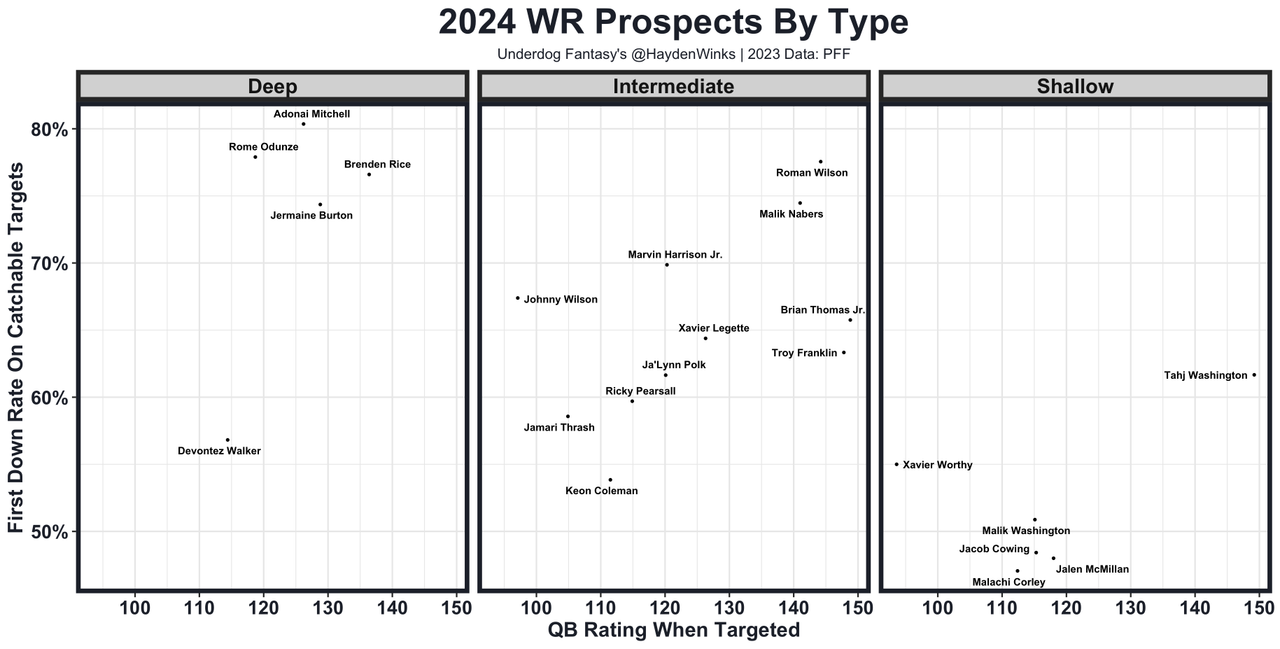
WR16 Malik Washington (Early Round 3)
WR Model: 54th percentile
Comps: Thicc Wan'Dale Robinson, Short King Summer Khalil Shakir
It took him until his 5th year and a transfer out of Northwestern to Virginia to breakout, but Washington dominated touches more than anyone in the class. He averaged 119 yards per game with 95th percentile team share of receiving, though when age adjusted (23.5 years old) that drops to the 83rd percentile. Some of his production was fake, too, as only 51% of his catchable targets went for a first down, which is among the worst in the class. On tape, he was schemed up screens, sweeps, and option routes underneath, leading to an extremely low 8.1 average depth of target. His compact frame (5'8"/191) allows him to bounce off defenders after the catch and he has the short-area burst (42.5-inch vert) to run by the first tackle. Only Malik Nabers avoided more tackles per reception in the class. Washington's lack of stride and catch radius prevent him from playing on the outside (7% of snaps), so there's a hard cap to his ceiling. Among the jitter bug slot types, Washington's agilities were just average. He just plays really strong.
WR17 Jalen McMillan (Round 3)
WR Model: 48th percentile
Comps: Tyler Boyd, K.J. Osborn, Khalil Shakir
A lot of his production was based on Washington's advantageous scheme, where McMillan played off motion or in bunched sets. He rarely faced man coverage out of the slot and had a career 19% contested catch rate. McMillan played out of control at times (leading to drops), and he didn't have the quick lateral ability of the typical slot receiver. He's different in that he can work downfield, sometimes using double moves. Applying too much weight into McMillan's statistical profile is somewhat unfair while playing next to Rome Odunze and Ja'Lynn Polk, but he did have 25th percentile age-adjusted production and 7th percentile team share of receiving. When thrown the ball, McMillan only turned 48% of his catchable targets into first downs (only Corley was worse in this class).
WR18 Javon Baker (Round 3)
WR Model: 61st percentile
Comps: Michael Gallup, James Jones, Romeo Doubs
He committed to Alabama after receiving offers from everywhere, but Baker couldn't beat out John Metchie and Jameson Williams for playing time. Most can't! After transferring to UCF, he led his team in receiving in back-to-back years with a 33% yardage share as a senior. He finished with 47th percentile age-adjusted production, partially inflated by two really long broken play TDs which explain his above-average yards after the catch numbers. On tape, Baker ran real routes at X receiver against press man coverage and won often. He's physical at the catch point, but he created a ton of separation with both releases and bend at the break point. Baker can win contested, though he had a few downfield drops while playing out of control. In fact, two of his drops led to the funniest INTs you'll see. He's still a choppy-footed route runner and has 25th percentile weight-adjusted speed (4.54 forty at 6'1"/202), so Baker may have to play in traffic at the pro level as a low-volume No. 3 receiver who will be put in some difficult on the line of scrimmage situations.
WR19 Malachi Corley (Early Round 4)
WR Model: 63rd percentile
Comps: Jarvis Landry, Laviska Shenault, Amari Rodgers
The Deebo Samuel comparisons are real rich to me because Samuel can run downfield routes, too. Corley faced weak competition at Western Kentucky and ran a bunch of Mickey Mouse routes (5.5 aDOT and 3.8 air yards per catch) like whip routes, screens, and double moves. There are few NFL reps on his tape and I didn't see the Deebo yards after catch ability despite a few highlight truck sticks. There's no doubting his toughness and strength. I'd be surprised if he was a full-time player as a rookie, especially considering he was in the slot on 86% of his routes. With more experience, Corley can be an underneath slot receiver in 3-WR sets.
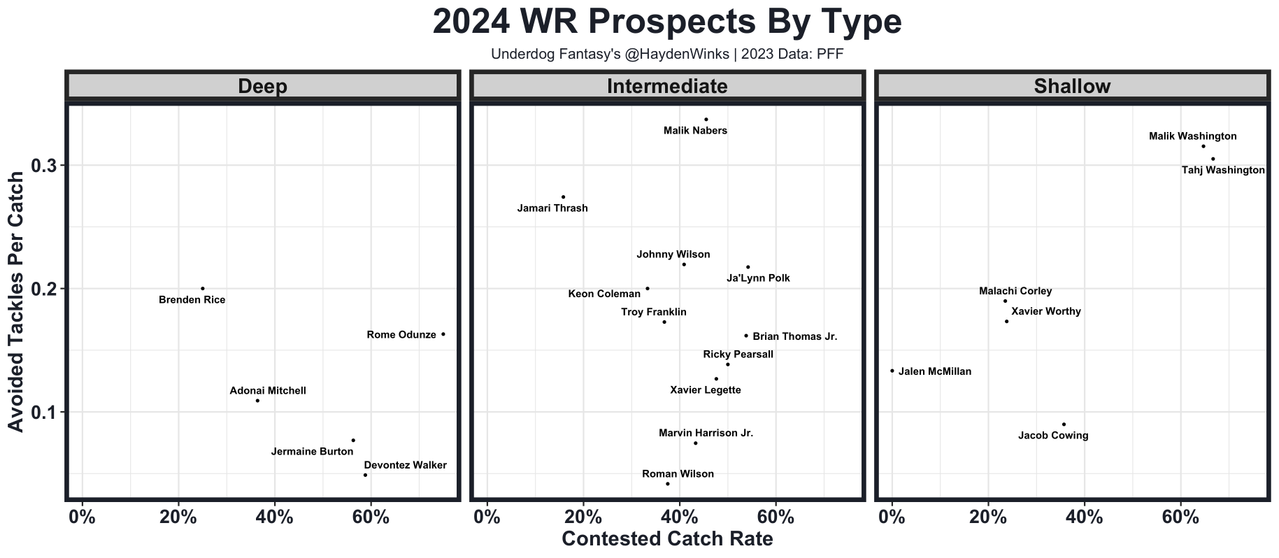
WR20 Devontez Walker (Round 4)
WR Model: 56th percentile
Comps: DJ Chark, Kenny Stills, Tyquan Thornton
He's an Alec Pierce type who can primarily play on a straight line only. I was underwhelmed on my first watch of his because of his lack of bend and tendency to play into contact at the catch point. Walker had an absurd 18.2 aDOT, probably because he can't run underneath routes at a high level. His inconsistent play is worrisome because he faced a weak strength of schedule with a stud QB. The environment was ideal. The production wasn't.
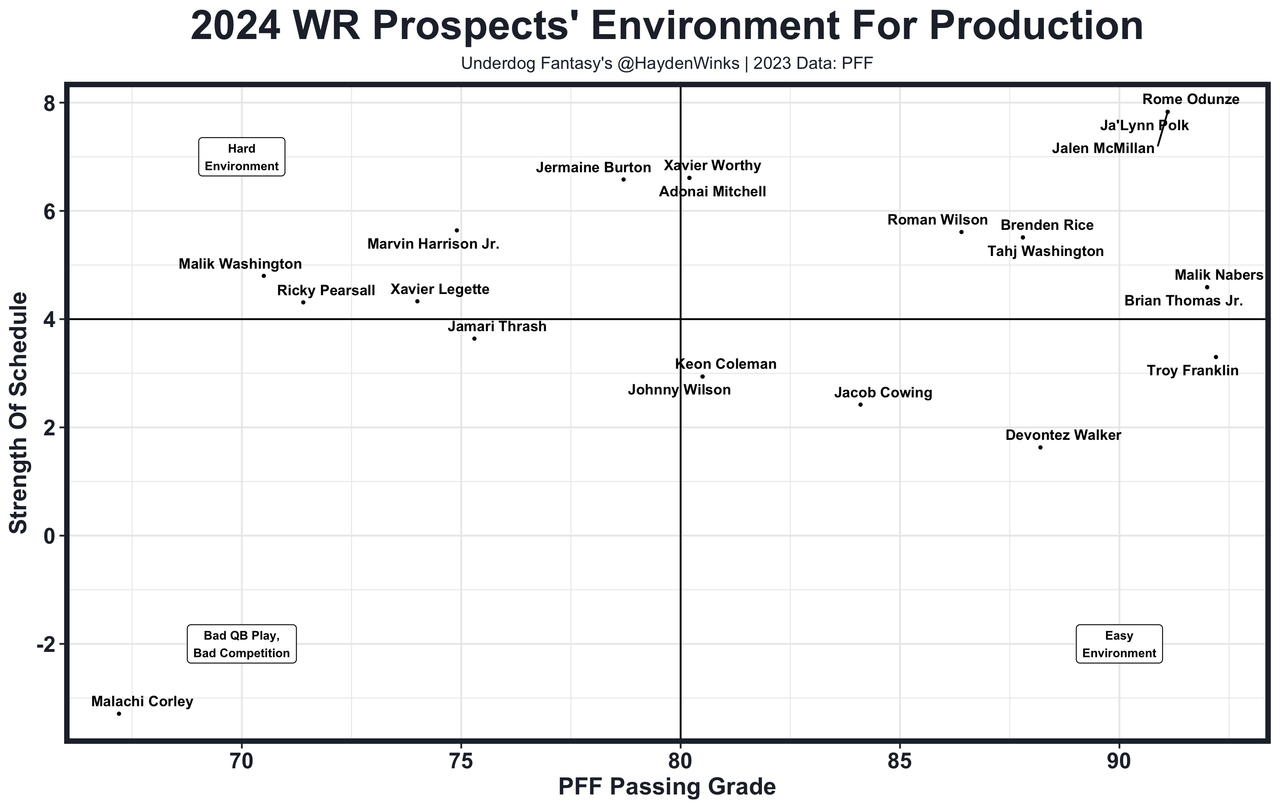
WR21 Brenden Rice (Round 4)
WR Model: 54th percentile
Comps: Joshua Palmer, Gabriel Davis, Isaiah Hodgins
Yes, he's the son of Jerry Rice. No, he doesn't have the juice like him. Brenden invites contact because of a lack of separation due to below-average speed. He does have a nice catch radius with plenty of size (6'2"/208), but he's just not a separator on film. His 4.51 forty surprised me.
WR22 Tahj Washington (Round 4)
WR Model: 45th percentile
Comps: Jamison Crowder, older Josh Downs
He's a vertical slot option out of USC with quality ball tracking and yards after the catch ability but a complete lack of size (5'10"/185). Washington was stuffed in the screen game on occasion, can't be a full-time player in the NFL, and will only play in the slot. He can be a nice rotational threat in 3-WR sets, however, because his reliable hands and route running fit in spread style offenses. Washington's EPA per route and success rate per target are both top-5 in the class, and he had the most yards after the catch over expected. His numbers are inflated by Caleb Williams' dominance and Washington's age (23 years old). Sadly, there aren't many comps of success receivers with his frame and 4.58 speed (bottom 1st percentile speed score). They are Tank Dell, Jordan Addison, Josh Downs, Jamison Crowder, Mario Manningham, and Hunter Renfrow.
WR23 Jamari Thrash (Round 5)
WR Model: 33rd percentile
He ran real routes at Louisville, facing press man coverage often and having to work at intermediate depths from the outside (90% snaps out wide). Thrash doesn't have standout size or athleticism, however. His best route was a comeback where he can sink his hips. His mediocre speed hurt him on downfield routes. His slender build works against him on in-breaking routes, leading to some drops. It's possible Thrash looks better off the line of scrimmage, but he falls in the late breakout and 5th-year declare bucket after transferring from Georgia State to Louisville.
My Historical WR Grades
My write-ups from the 2022 class and 2023 class are here.
Marvin Harrison (Early Round 1)
Malik Nabers
Rome Odunze
Drake London (Mid Round 1)
Garrett Wilson
Brian Thomas Jr.
Jameson Williams
Jaxon Smith-Njigba
Chris Olave (Late Round 1)
Ladd McConkey
Jordan Addison
George Pickens (Early Round 2)
Adonai Mitchell
Xavier Worthy
Treylon Burks
Ricky Pearsall (Round 2)
Jalin Hyatt
Keon Coleman
Troy Franklin
Skyy Moore
Jahan Dotson
Quentin Johnston
Ja’Lynn Polk (Late Round 2)
Johnny Wilson
Jermaine Burton
Xavier Legette
Cedric Tillman
Zay Flowers
Roman Wilson
Jonathan Mingo
Josh Downs (Early Round 3)
Khalil Shakir
Malik Washington
Tyler Scott
David Bell
Marvin Mims (Round 3)
Jalen McMillan
Javon Baker
Malachi Corley (Early Round 4)
Devontez Walker (Round 4)
Brenden Rice
Tahj Washington